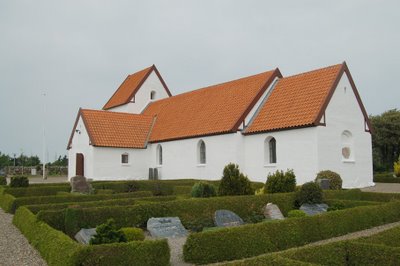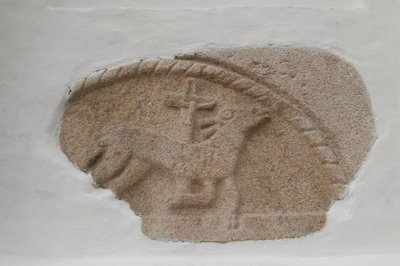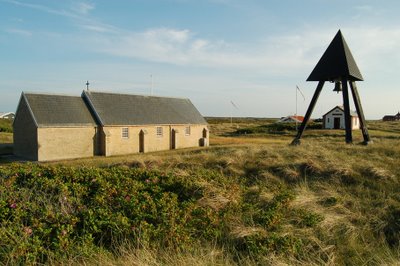
Karby church

The interior

The Renaissance pulpit

The Baroque sounding board above the baptismal font

Coat of arms on a church stool , (Thomas Kaas of Ørndrup , his maternal coat of arms)

Romanesque remains by the wall

One of the lion reliefs on the church wall
Karby Church is placed upon a hill in the middle of Karby village near Visby bredning (a bay) by Limfjorden. It is the largest village church upon the island of Mors and is called "The Cathedral of Mors'" The original building in granite boulders is from 1100s, and the rest is built by stages.The large church in Karby is both with its strange Romanesque architecture and its rich inventory of immense antique interest. The Romanesque apse, chorus and nave were followed by five Gothic additions , the porch, tower, sacristy, a western addition and the southern chapel.
The apse and choir are in granite ashlars, built in a primitive technique suggesting high age. The apse was originally higher than now, it has a corniche frieze in ashlars with round arched fields, it is decorated with reliefs. Two ashlars with lions frame the walled-in east window, which is not visible in the changed outer wall. Inside the window is bricked up below the cover store from the outer window. In the choir are some ashlars removed and re-used in the south chapel. Apse and choir ar both circular, the apse with kragsten, the choir without. The Romanesque section of the nave is in raw field stones.
The south door has disappeared and profiled frame ashlars placed on the north side of the nave probably origins from here. The north door is very changed, two of its frame ashlars are placed in the walls of the porch which was built in front of this door. The porch is now used as a tool shed. It is built in monk bricks above a single ashlar course. The western extension's north wall is ashlar in the bottom and monk bricks above. The heavy western tower has ashlars and raw boulder at the bottom and monk bricks above. The tower room with the original cross-vault opens to the nave in a broad point-arched archade. Access to the middle storey of the tower by a free stairway to the north.
The sacristi at the north side of the choir is built in monk bricks above an ashlar course. It has an original cross-vault and a door to the choir. The large south chapel is built in ashlars and raw boulder, partly re-walled after a fire in 1946. The chapel has a round-arched archade to the nave and the windows of the chapel are like other windows of the church much changed. The vault of the sacristi is covered in frescoes from the 1700s of achantus runners and circular medaillons with figures of the Evangelists.
The Romanesque granite communion table is covered in a Renaissance panel with archade-fields from ab. 1600, the top is a monolite-plate and has a relique covered with a stone. The altar piece is Bruskbarok (from ab. 1690) with painting from 1920, the earlier and original painting hangs upon the wall of the nave. The Romanesque granite font is of Morsing-type ; it has a richly decorated Baroque sounding board. The baptismal basin is a Nürnberg-work from ab. 1575. Above the north door of the nave is a small choir-arch crucifix from ab. 1700. The pulpit origins from ab. 1600 with pietistic paintings and a new sounding board with a pidgin. Except the pews beelow the gallery and in the south chapel the pews in the church are Renaissance from 1600-25. Two pews are richly decorated and has the paternal and maternal coat of arms of Thomas Kaas and Anne Vind. The pews by the north door have pretty carved panels. A western gallery from 1680 with contemporary paintings and an organ from 1904. An iron bound pengeblok (money block) Two church bells from 1638 cast by Jørgen Hansen in Århus and Franz Voillard of France.
North of the nave is a strange arrangement of four granite posts which were found in 1913 under the floor of the nave.
Names in the Middle Ages and 1600s:
Karby (*1297 Karleby)
Næs (* 1418 Nees); Torp (* 1505 Thorp); Agerøby (1688 Aggerbye); Ørndrup (*1452 Ørndrup).
Ørndrup belonged in 1452 to Christen Borre, in 1455 to Mogens Borre and later to Erik Høeg (of the family Banner), who fell in Ditmarsken in 1500. His sister Abel Høeg brought it to her husband Niels Kaas (of the family with a sparre (chevron) in their coat of arms, who was the owner of Ørndrup in 1504 and 1511. In 1523 and 1540 it belonged to their son Mogens Kaas, after him to his sons , Niels, Iver and Jens Kaas. The last mentioned died in 1609, his son's son Thomes Jensen Kaas of Ørndrup died in 1651. His daughter Kirsten Kaas (+1693) married Valdemar Skram - the peasants of the district still sang a libellous song about her in the 1700s. Various owners up till the present.
Næs was earlier a farm of the nobility, where in 1418 Mogens Andersen lived and after him it belonged to his daughters Marine, (Peder Svendsen's widow) and her sister. The last mentioned was married to 1) Poul Jensen (or Nielsen), and 2) to Christen Lauridsen. The son of first marriage, the priest Jens Poulsen made an attempt to gather the estate Næs by out-buying his maternal aunt in 1485 and his many half-siblings and then gave it to Voer Kloster in 1490. He had a co-owner, his half brother Laurids Christensen, who also bought parts of the farm and in 1501 pawned a part of Næs to Dueholm Kloster. His sister Kirsten Christensdatter pawned in 1510 a part of Næs to Vestervig Kloster and was still at Næs in 1515. In 1474 Erik Abildgård was mentioned at of Næs.
Belonging to Ørndrup is mentioned the house Spangen (1664 Spangen, 1688 Spanhutte) and Strandmølle (1664 Stran Mølle).
Listed prehistorics: At Ørndrup the passage grave Torshøj (1638 Tudsberge Høje) with a chamber of 10 carrying stones, but only one cover stone preserved. The hill Arbjergtorn at the vicarage.
Demolished or destroyed: 35 hills, i.e. 3 Trealshøje (1638 Treellshøje) south of Karby.
A large stone in Limfjorden between Karlby and Heltborg. - Klingersten(e) in Torshøj Dyb close to the water's edge north of Ørndrup.
Source: Trap Danmark, Thisted amt, 1961
photo 24 August 2007:grethe bachmann

















































